How To Apply Top-Down Analysis For Identifying The Best Breakouts
Eddie Kwong: How are you doing, Gary?
Gary Kaltbaum: Very good.
Kwong: I was talking to you a couple of weeks ago, and you were saying that you’d been catching breakouts right and left, both to the long- and the shortside. Maybe you could give our members a little lesson here on how you do it, especially in this tough environment. That’s what everybody’s interested in hearing.
Kaltbaum: Yeah, I think that the best thing about this market is that it’s giving opportunities on both sides and on a pretty clear and definitive pattern. There’s really no in-between. It’s either feast or famine, and basically all I do is I get tunnel vision, and at night when I’m doing my work, it’s just basically drumming out all the noise. You forget about all opinion. You forget about what everybody thinks, and you look deep into the market at sectors and individual stocks that make them up, and you look to find specific themes that stand out like sore thumbs.
For instance, if a certain group has 10 stocks in that group out of nowhere busting out to new highs on heavy volume, you have a theme there. Conversely, you look for the other side of the story also. That’s what kept us mostly short technology for the past several months is the fact that the whole group was rallying on light volume and getting trashed on heavy volume as it broke support. So, it’s really a matter of tunnel vision and picking your spots and going slow and not trying to be too much of a hero on anything.
Kwong: I see. Have you found, however, in general, that it’s been more slim pickings as opposed to a more favorable environment?
Kaltbaum: You know what? It goes through periods of time where it gets to be slim pickings. I can tell you right now, to me, it’s a time where you take a step back because you had a follow through in the markets, but you have no stocks breaking out, but you have a lot of stocks still acting ugly, and you want to short them, but you really can’t because you have a follow through. So, you basically take a step back and wait for a real trend to find itself. So, yeah, there are points where for a couple of weeks, I’m hardly putting out anything, and then out of nowhere, I’m putting out 10 or 15 different things on a nightly basis because they start showing up. It’s just a matter of not anticipating, not forcing things, and things show themselves up both on the long- and short side. You just have to wait for them to happen.
Kwong: Now, the perception that a lot of people have, in fact most people that I talk to, is that the market is kind of choppy right now, and that there’s a lack of follow through, a lack of trending. Do you find that that affects the quality of your breakouts? In spite of the fact that you’re able to find tradable breakouts, do you find that they follow through a little less?
Kaltbaum: Yeah, exactly. When you have a scenario where you have a lot of whippiness and a lot of backing-and-filling, that’s a point where you see that things that break out don’t work as well, and some tend to fail pretty quickly. And on the short side, which is always going to be a lot tougher, of course, depending on market conditions because you can get short squeezes and things like that, when you get a follow through like you’ve had in the last couple of weeks, it’s where things can look great, you want to short something, and the next day it’s up three dollars only because the market had a good move. So, it does get much tougher right now, but you recognize that. And what do you do in this situation? You tighten up your stops. In the whipsawiness, you are going to miss a few, and by tightening your stops, you never lose too much, so you’re always around for the next game. The one who gets buried is the one who sits there and just sits there and sits there waiting for something to come back, and before you know it, it never does, and you’re out a lot of money.
Kwong: Yeah. You mentioned how what individual stocks do vs. the overall market does hangs over everything that you do. So, do you pay a lot of attention to what the overall market is doing? Or do you find that the breakouts pretty much take care of that, and it’s just a market-timing issue for you?
Kaltbaum: You definitely have to look at the overall market. You always have to work within the overall market’s framework. For the past few months, you’ve had some good months and bad months. But even during the bad months, there were stocks working. I remember when this market was acting very poorly, but Quest Diagnostics ^DGX^ and ^LH^, they do exactly the same thing, but both broke out of sound bases, and both stocks went up 20% in pretty short order. So, you can’t be swayed by a bad market because what you’ve had in recent years is good markets and bad markets, but it’s more sector analysis. You can have a bad market and still have 10 sectors that act well.
Kwong: I see.
Kaltbaum: So, you’ve got to pick it apart, not just buy “the market” as everybody says, but what’s inside the market.
Kwong: Do you follow any kind of market-timing indicators as a general guide on whether to focus on longs or shorts?
Kaltbaum: Well, first off, you always look for the follow-through day for longs. You want to know you have the wind at your back. It’s much easier to make money. That’s number one. And really on the short side, it’s more the tone of individual stocks that we look at. First off, you’ll know the market’s in a downtrend just by watching it. That’s the obvious thing about a market breaking support and having high-volume distribution days. But you also want to see a lot of stocks in the same group setting up in the same way.
I remember Feb. 14, 2002, Valentine’s Day, I was just sitting. We had nothing going. And just out of nowhere, I wrote to my people that this baby is setting up to get really whacked here because a whole host of technology stocks were wedging up on lighter volume after big drops, which really almost always leads to lower prices. And lo and behold, within days, the market crapped out and we had some really good gains, actually some pretty sizable gains.
So, it’s just a matter of watching things. It goes from the market to the sectors to the individual stocks, and I don’t see it as one being more important than the other. It’s all three put together.
Kwong: I see. So, one of the ways you might develop an opinion about the market as a whole is by the plurality of bearish patterns, let’s say, in a group of stocks. In this case, you saw a whole group of technology stocks setting up the same way, so the conclusion was that that might have a downward pressure on the market as a whole.
Kaltbaum: Absolutely. A good example is just this week. I was out last week, and everybody’s talking about tech, tech, tech, tech. Well, you had a follow-through day, so you can get upside testing, but I found 40 techs stocks, some pretty important, that look shortable on rallies into resistance. And when I see that many names, it tells me I don’t know how much upside there is here. Anything can happen. I’ve seen bad markets turn into good overnight. But when I see 40 or 50 tech names that look like a horror show and look like they have no upside, it says to me, “Boy, this thing has a lot more work to do before it can really get going,” and odds favor you’re going to get some pullbacks here before you can really get excited. And he who tries to force it too much is going to get hurt.
Kwong: Yeah. Let’s talk a little bit about, and I know you’ve already touched on it, where the opportunities have been over the past couple of months or so. Maybe talk some more about specific names that you’ve made recommendations on, and give us a snapshot of what some of the typical setups have looked like, both on the long- and short side.
Kaltbaum: Sure. Well, on the long side, it’s not the normal what you used to have, all the high-flying stuff. We’ve got tunnel vision, and we’ve looked for stocks that have been basing out for a long period of time, and then break out above those bases – the longer the base the better – on heavy volume. Names that we’ve put out that I’m amazed are working, are names like ^AN^ at $14, ^AM^ just recently at $18, and you can just take a look at the charts of some of these things how they broke out on monstrous volume moves, which indicates serious conviction by the institutional crowd, and usually you get some wins out of them.
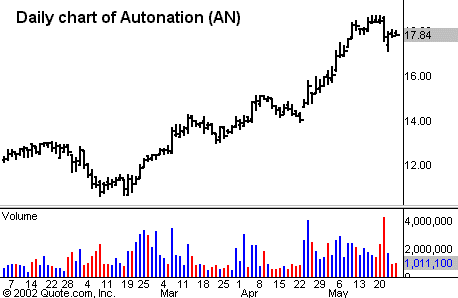
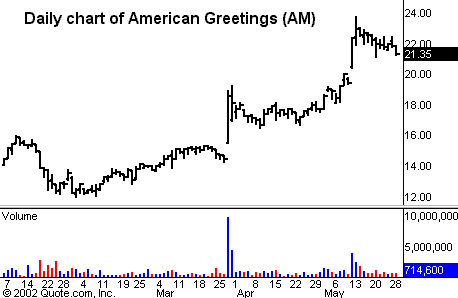
Other names — and like I said, these are boring, but we’ll take boring any day of the week – we had ^STJ^, ^UAG^ the same group as AutoNation, so it’s been one giant boring-fest, but you know what? In this market, boring is good.
On the short side, it’s been mostly tech. We had some monstrous shorts, like ^GNSS^ for 30 points. We had ^BGEN^ you know the biotechs got trashed, which was a nice 10-11 pointer for us. And then you had the old ^EMLX^, ^BRCM^, ^NTAP^ stocks. ^RIMM^, ^CHKP^, ^ORCL^, which we put out at, I think, 14 or 15 and watched it bottom at 7 and change.
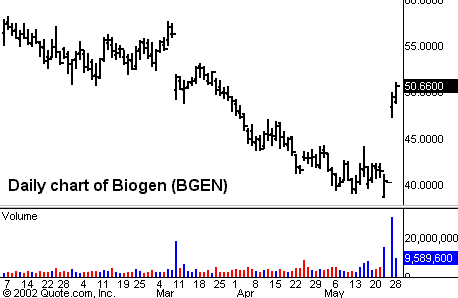
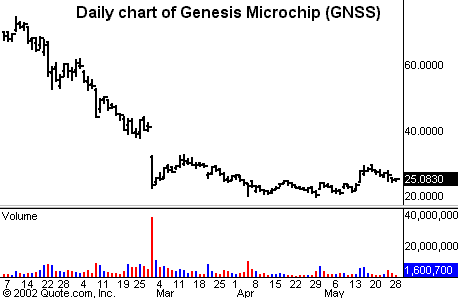
So, you know, themes have been sticking out like a sore thumb, and I don’t believe themes change overnight, and that’s what’s got me worried about tech. The other thing, and we’ll talk about this in a minute, is sentiment, where I’m still worried about what I’m seeing on that front.
Kwong: Tell me a little bit about what you’re seeing on sentiment.
Kaltbaum: I have never seen new bull markets start off where everybody’s bullish. And my measurements of sentiment are still ridiculously high, and this is after a 70% drop off in the Nasdaq. For instance, we look at percentage of bullish and bearish advisors. Bulls are up near the highs here, and they’ve stayed that way all the way down. They’ve been long all the way. I don’t see where all of a sudden they’re going to be light. Put/Call ratios, there’s not much going on there, except for at the low on Sept. 21 where it spiked up. The VIX and VXN which we watch, there’s not much there. And the biggest worry is market strategists. Every rally, they double up on their bullishness. And these are people that, if you followed them for the last two years, they were buried. I just don’t think you have the makings. I do think you have the makings of some upside movement here just because of the follow through. And the first thing we look at is the technicals. As I said, we’re going to play it day-by-day and not try to force it, and we’ll see how it comes out of here.
Kwong: What do you think it would take to get everybody in the right pessimistic state of mind for a bottom to develop?
Kaltbaum: Time. Being fed up. The type of talk “I’ve had enough of this.” I’ve seen a little bit of that in technology. I mean, you see names like ^NT^ and ^JDSU^ PowerRating). You get to that give-up phase. I just don’t know if I’ve seen it just yet. The good news is that on an average stock front, it is doing better. It’s not what everybody’s used to. I mean, I look at stocks like ^BC^ and ^BDK which are on the leadership front here, which is something that nobody’s used to, but I think you better get used to it. I just haven’t seen the real capitulation that really marks the end.
And you’ve got to remember another thing. We’re in new territory, 75% down on the Nasdaq 100. I just think it’s going to take years to flush this thing out, and I think you’ve got to be careful.
Kwong: I guess what comes to my mind are two possible scenarios: Either we trade in a trading range for a long, long time, and that sort of wears everybody out, and they just throw in the towel; they’re not interested in the markets anymore. Or you just get a very steep and high-velocity plunge to levels that people thought we never would reach, and that panics everybody, and there’s a sharper hairpin turnaround.
Kaltbaum: Well, that’s what happened Sept. 21, but I have to tell you that a great point that you just made is the fact that the $SPX.X which was everybody’s measuring stick for years, is at the same place it was four years ago. But you don’t hear anybody talking about that. You just hear them talking about what’s the hot stock today. I think that’s something that has to be looked at, has to be noticed because one of the most important indices not moving in four years and being down 30%, I think that’s a telling tale of the market here. If you look at a monthly chart of the S&P, it looks like one big, giant broadening top.
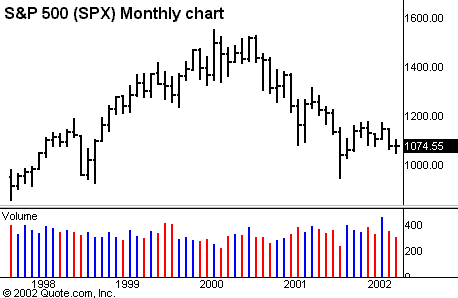
As you can tell, I have this bias to be negative. If that changes, I’m a technician, I will be all over it. I just think that every one of these rallies look the same, the same type of rally that’s happened over the last two years, the sharp, quick get-me-in-type rallies, but the only disappoint you later. I think what’s happened recently reminds me of everything we’ve seen since March of 2000, and until I see that pattern change, I’m going to be wary, and I’m going to be skeptical of it, and I’m going to look to be shorting on the service on them.
Kwong: OK. Gotcha. Well, Gary, I really want to thank you for taking the time with us once again.
Kaltbaum: You bet.
